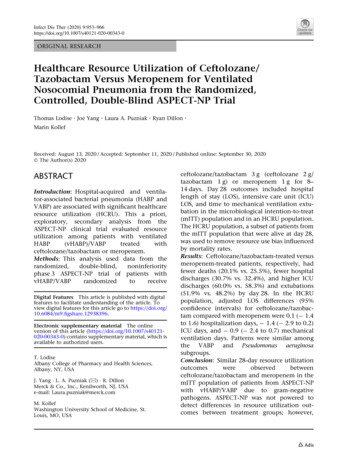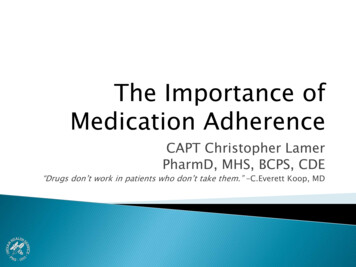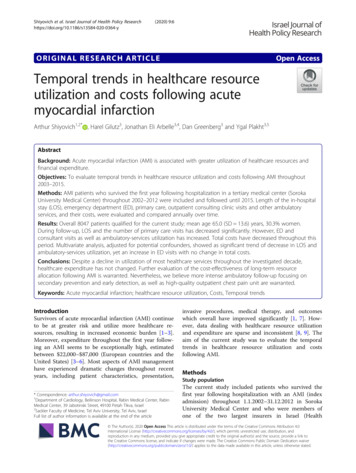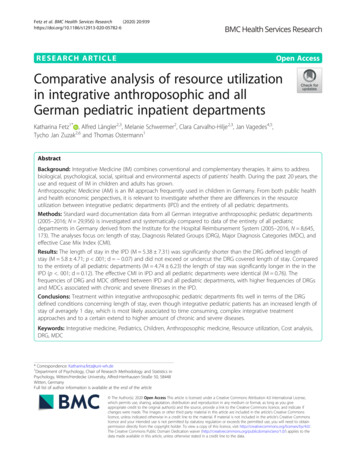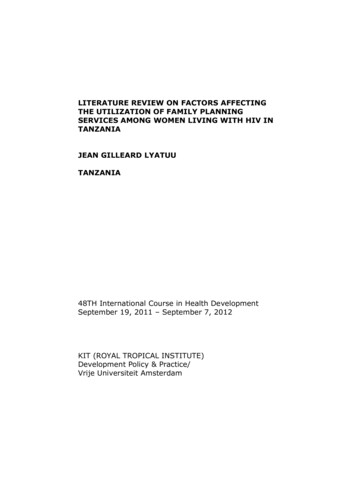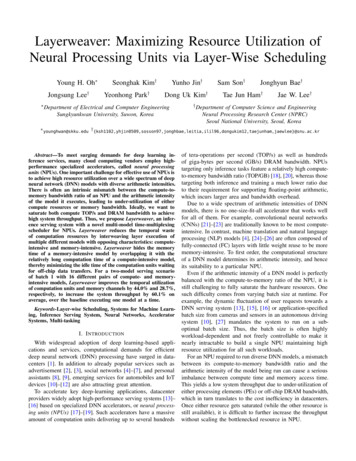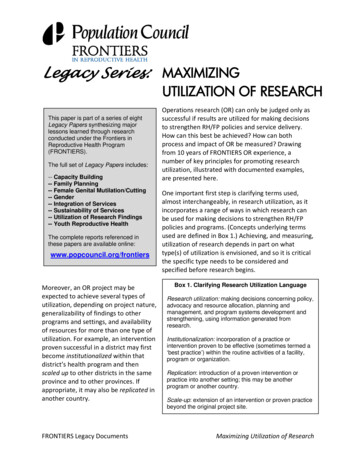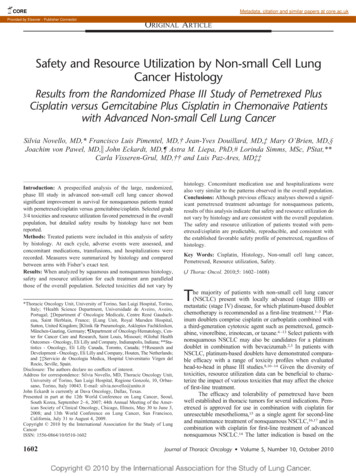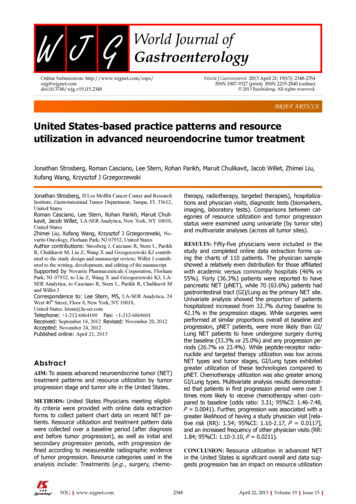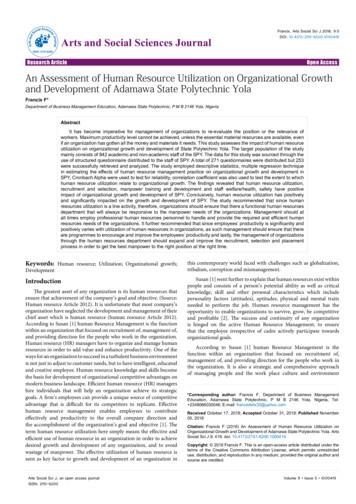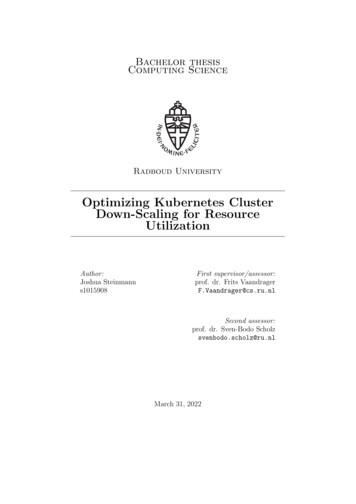
Transcription
Pilon et al. BMC Psychiatry (2017) 17:207DOI 10.1186/s12888-017-1358-3RESEARCH ARTICLEOpen AccessAdherence, healthcare resource utilizationand Medicaid spending associated withonce-monthly paliperidone palmitateversus oral atypical antipsychotic treatmentamong adults recently diagnosed withschizophreniaDominic Pilon1* , Erik Muser2, Patrick Lefebvre1, Rhiannon Kamstra1, Bruno Emond1 and Kruti Joshi2AbstractBackground: Once-monthly paliperidone palmitate (PP1M) is a long-acting injectable antipsychotic that may increaseadherence rates, reduce hospitalizations, and lower medical costs compared to oral atypical antipsychotics (OAAs) amongschizophrenia patients. However, the impact of PP1M in recently diagnosed patients remains unknown. The present studycompared adherence, healthcare resource utilization and Medicaid spending between schizophrenia patients initiatingPP1M versus OAA, among patients recently diagnosed (defined using ages 18–25 years as a proxy) and among theoverall population.Methods: Medicaid data from five states (09/2008–03/2015) were used to identify adults with schizophrenia initiated onPP1M or OAAs (index date) on or after 09/2009. Outcomes were compared between PP1M and OAA groups followinginverse probability of treatment weighting (IPTW). Univariate linear and Poisson regression models with nonparametricbootstrap procedures were used to compare the 12-month healthcare resource utilization and costs using rate ratios(RRs) and mean monthly cost differences (MMCDs), respectively.Results: Overall, patients initiated on PP1M (N 2053) were younger (mean age: 41 vs. 44 years) and had morebaseline antipsychotic use (88% vs. 62%) compared to OAA patients (N 22,247). IPTW resulted in balanced baselinecharacteristics. Among recently diagnosed patients, PP1M was associated with better adherence (PDC 80%: 29% vs.21%, P 0.001) on the index medication as well as less use of other psychiatric medications, compared to OAAs.Adherence findings were similar for the overall cohort. Among recently diagnosed patients, lower medical costsassociated with PP1M (MMCD -466; P 0.028) outweighed the higher pharmacy costs (MMCD 322; P 0.001)resulting in similar total healthcare costs across groups (MMCD -144; P 0.553). Overall, findings were similar butthere was a trend toward a lower magnitude of medical cost savings (MMCD -286; P 0.001). Reductions inmedical costs were mainly driven by reductions in inpatient days (recently diagnosed RR 0.85, P 0.353; overallRR 0.84, P 0.004) and in home care visits (recently diagnosed RR 0.43, P 0.008; overall RR 0.78, P 0.048).(Continued on next page)* Correspondence: dominic.pilon@analysisgroup.comPrevious presentation: Part of the material in this manuscript has beenpresented at the 28th American Psychiatric Association Annual Meeting, May14-18, 2016, Atlanta, GA1Groupe d’analyse, Ltée, 1000 De La Gauchetière West, Suite 1200, Montréal,QC H3B 4W5, CanadaFull list of author information is available at the end of the article The Author(s). 2017 Open Access This article is distributed under the terms of the Creative Commons Attribution 4.0International License (http://creativecommons.org/licenses/by/4.0/), which permits unrestricted use, distribution, andreproduction in any medium, provided you give appropriate credit to the original author(s) and the source, provide a link tothe Creative Commons license, and indicate if changes were made. The Creative Commons Public Domain Dedication o/1.0/) applies to the data made available in this article, unless otherwise stated.
Pilon et al. BMC Psychiatry (2017) 17:207Page 2 of 18(Continued from previous page)Conclusions: PP1M patients demonstrated significantly lower medical costs offsetting higher pharmacy costs relativeto OAA patients. Recently diagnosed patients using PP1M may have greater medical cost savings relative to OAAs thanthat observed in the overall population, highlighting the potential economic impact of PP1M in adults recentlydiagnosed with schizophrenia.BackgroundSchizophrenia is a debilitating chronic mental illnesswhich is one of the top 20 leading causes of disabilityworldwide and is associated with a high cost burden [1, 2].The overall cost of schizophrenia in the United States(US) in 2013 was estimated at 155.7 billion, with nearlyone-quarter of this cost incurred as direct healthcare costs[2]. The large burden of schizophrenia can be attributedin part to the early onset of the disease, typically in theearly-to-mid 20s for men and in the late 20s for women;which then frequently persists as a chronic, lifelong illness[3]. Therefore, patients with recently diagnosed schizophrenia, including younger patients for whom disease onset is very likely to be recent, represent an importantpopulation for developing and targeting interventions.Suboptimal disease management and multiple relapseshave been associated with a poor functional prognosis[4] and reduced responsiveness to antipsychotic (AP)therapy [4, 5], and can beget a cycle of economic, social,and legal challenges that pose further barriers to effective intervention [6]. Therefore, treating patients early inthe course of disease, when they may be most treatable,is of high priority to minimize the risk of serious longterm consequences [7]. While antipsychotic (AP) therapy is an effective tool in managing the symptoms ofschizophrenia and preventing relapse, non-adherence totherapy is common [6]. Moreover, patients early in thecourse of disease may be particularly at risk for nonadherence, due in part to lack of insight into their ownillness [8, 9].Although the determinants of non-adherence arenumerous and complex, medication-related factors suchas the choice of AP therapy and dosing frequency areamong its important drivers [6, 10]. For example, longacting injectable therapies (LAIs) can be administeredless frequently (once every 1 to 12 weeks) than daily oralAPs and are typically healthcare provider-administered,meaning that once the injection is received, no furtheraction is required by the patient for the duration of thatdose. Current evidence suggests that for patients withschizophrenia in general, using second-generation LAIsmay be associated with lower rates of disease relapseand reduced morbidity when compared to oral atypicalAPs (OAA), likely through increasing medication adherence [11–14]. Once-monthly paliperidone palmitate(PP1M) is one such LAI that was approved in 2009 bythe FDA for the treatment of schizophrenia in adultsand in 2014 by the FDA for the treatment of schizoaffective disorder [15].It has been previously demonstrated that recentlydiagnosed adults with schizophrenia can tolerate and besafely and effectively treated with LAIs including PP1M[16–18]. Notably, a recent post-hoc analysis of trial datahas suggested that the magnitude of the impact of PP1Mversus oral APs on treatment failure may be greateramong patients with recent-onset illness than amongchronic patients [18]. Importantly, this was an underpowered secondary analysis; therefore, there is a needfor real-world evidence addressing whether LAIs couldincrease rates of adherence and influence subsequenteconomic outcomes in patients with recently diagnosedschizophrenia. This study aims to evaluate adherence,healthcare resource utilization, and Medicaid spendingin patients with schizophrenia treated with PP1M ascompared to those being treated with OAAs among afive-state Medicaid population, among patients aged 18to 25 years as a proxy for being recently diagnosed withschizophrenia and among the overall cohort of patientswith schizophrenia.MethodsData sourceThis study was conducted using Medicaid healthcareclaims databases from New Jersey, Iowa, Missouri, Mississippi, and Kansas. Data were available from September1, 2008 through March 31, 2015 for all states except forNew Jersey, which had available data until March 31,2014. The available data included patient eligibility records (e.g., age, gender, race, enrollment start/end dates),medical claims (e.g., type of service, date of service,International Classification of Diseases, Ninth Revision,Clinical Modification [ICD-9-CM] diagnoses, CurrentProcedural Terminology [CPT] procedure codes, andHealthcare Common Procedure Coding System [HCPCS]codes), and prescription drug claims (e.g., days of medication supplied, date of dispensing, and National DrugCodes [NDC]). All available cost data reflect the Medicaidpayers’ perspective prior to any discounts or rebates paidby manufacturers. All data were de-identified and incompliance with the Health Insurance Portability andAccountability Act (HIPAA).
Pilon et al. BMC Psychiatry (2017) 17:207Study design and patient selectionA retrospective longitudinal cohort study was conductedusing adult Medicaid beneficiaries with schizophrenia tocompare treatment patterns, healthcare resource utilization,and Medicaid spending in patients who were initiated onPP1M versus OAAs. The treatments of interest in thisstudy included PP1M and nine FDA-approved OAAs (i.e.,aripiprazole, asenapine maleate, iloperidone, lurasidone,olanzapine, paliperidone, quetiapine fumarate, risperidone,and ziprasidone).To be included in the study, patients were required tomeet the following criteria: (a) have at least two pharmacy/medical claims for PP1M or at least two pharmacyclaims for the same OAA agent within 90 days startingon or after September 1, 2009 with no claims in the previous 12 months (baseline period; the date of the firstclaim was defined as the index date), (b) have at leasttwo diagnoses for schizophrenia (ICD-9-CM codes:295.xx) during the study period, (c) be at least 18 yearsof age on the index date, (d) have at least 12 months ofcontinuous Medicaid enrollment prior to the index date,and (e) have at least 12 months of post-index continuousMedicaid enrollment. Outcomes were evaluated during afixed 12-month observation period including and following the index date. Baseline demographics and clinicalcharacteristics were evaluated during the 12-monthperiod prior to the index date.Treatment cohorts were defined by the agent initiatedon the index date. Agents were identified using the generic product identifier (GPI) code and/or the HCPCScode. All outcomes were evaluated both for PP1M andOAA patients aged 18–25 years at the time of diagnosis,using age as a proxy for recent schizophrenia diagnosis,and for the overall cohort (aged 18 years).Study outcomesOutcomes included treatment patterns, all-cause healthcare resource utilization, and healthcare costs, measuredover the 12-month observation period for each patientand compared between PP1M and OAA treatmentgroups.Treatment patterns, evaluated during the observationperiod, were described. They included the duration ofcontinuous exposure to the index agent (spanning fromthe index date to the end of the days of supply of thefirst fill for which the next fill of the index treatment, ifany, is 90 days later), the number of dispensings of theindex agent, psychiatric medication use (other than theindex agent) by type, the presence of AP polypharmacy(i.e., overlapping coverage of 2 unique AP agents for 60 consecutive days with no more than a 7-day gap),and the presence of psychiatric polypharmacy (i.e., overlapping coverage of 1 AP and 1 anxiolytic, antidepressant, or mood stabilizer for 60 consecutive days withPage 3 of 18no more than a 7-day gap). Adherence (using theproportion of days covered [PDC] with 80% to defineadherent patients) and persistence (using no gap 30,60, or 90 days) were also evaluated at 12 months postindex date for any AP as well as for the index agent.PDC was defined as the number of non-overlapping daysof supply divided by the number of days in the observation period (365 days).For healthcare resource utilization, the frequency ofvisits/services was evaluated by type, in addition to thelength of stay which was evaluated for inpatient visits,long-term care admissions, and mental health instituteadmissions ( 1 day). Healthcare costs were evaluatedfor medical costs by type of service (i.e., inpatient visits,outpatient visits, emergency room visits, long-term careadmissions, mental health institute admissions [ 1 day],1-day mental health institute admissions, home healthcare services, and other medical ancillary services) aswell as for total pharmacy costs. Costs were based onthe Medicaid payers’ perspectives and reflect amountspaid by state Medicaid programs prior to discounts orrebates. As a sensitivity analysis, a 23.1% discount (themandatory minimum discount for branded pharmaceuticalproducts in Medicaid) [19] was applied to all pharmacyclaims for branded pharmaceuticals for the estimation oftotal healthcare costs and total pharmacy costs.Statistical analysisInverse probability of treatment weightingIn an observational study setting, many factors may beassociated with whether a patient receives one treatmentversus another, likely resulting in important differencesbetween the characteristics of the comparison groups(i.e., PP1M-treated vs. OAA-treated patients) whichcould confound the observed effect of the treatment onthe outcomes. To minimize the effect of potential confounding factors without reducing the size of the studypopulation, inverse probability of treatment (IPT)weighting was used to adjust for differences in baselinecharacteristics (i.e., evaluated during the 12-monthperiod prior to the index date) and compare outcomesbetween PP1M and OAA treatment groups. Weightswere calculated based on propensity scores (PS): 1/PSfor the PP1M cohort and 1/(1-PS) for the OAA cohortand normalized by dividing each weight by the mean. PSwere estimated using multivariate logistic regressionadjusted for the following baseline demographics andclinical characteristics: age, sex, race, state, region (i.e.,urban, suburban, or rural), insurance eligibility (i.e., presence of capitated and/or dual coverage), year and quarterof index date, Quan-Charlson Comorbidity Index (CCI)[20, 21], number of unique mental health diagnoses,number of unique psychiatric agents received, use of APmedications by type (i.e., typical vs. atypical and long-
Pilon et al. BMC Psychiatry (2017) 17:207acting injectable vs. oral), level of AP adherence (i.e.,PDC 80%), presence of AP polypharmacy, other psychiatric medication use (i.e., anxiolytics, antidepressants,or mood stabilizers), presence of specific comorbidities(i.e., cardiovascular disease, diabetes, obesity, drug abuse,hepatitis C, HIV/AIDS), and the numbers of baselinemental health institute admissions and 1-day mentalhealth institute admissions. PS for the recently diagnosed cohort of patients were estimated separatelywithin this population.Unweighted and IPT-weighted descriptive statisticswere generated to summarize the baseline demographicsand clinical characteristics of the study population. Percentages were used to summarize categorical variables,while means, medians, and standard deviations wereused for continuous variables. Standardized differenceswere used to compare baseline demographics and clinical characteristics between weighted cohorts and assessthe quality of the IPT-weighting, with the goal being toachieve clinically and statistically well-balanced cohortsaccording to an accepted threshold of 10% [22–24].Outcome comparisonsWeighted descriptive statistics were generated to summarizethe treatment patterns. Percentages were used to summarizecategorical variables, while means, medians, and standarddeviations were used for continuous variables. Treatmentpattern-related variables were compared between cohortsusing the Pearson chi-square test (categorical variables) orStudent’s t-test (continuous variables) after weighting.The 12-month cost outcomes were compared betweencohorts using mean monthly cost differences (MMCD)which were estimated using weighted ordinary leastsquares (OLS) regression models including a binary indicator for the treatment group. OLS was used given thatit provides estimates that are straightforward to interpretand correspond to the crude difference in means whenperformed without adjustment. All costs were standardized using the medical care component of the ConsumerPrice Index and reported as 2015 US dollars. Rates(number of events/days per person-year of observation)of healthcare resource utilization were compared between cohorts with the use of rate ratios (RRs) whichwere estimated using weighted Poisson regressionmodels which included only a binary indicator for treatment group. Because cost and resource utilization dataare positive values that follow a non-normal distributionand also often have zero values, P-value and 95% confidence intervals (CIs) for cost and resource utilizationoutcomes were estimated using a non-parametric bootstrap procedure (499 bootstrap replications).No adjustments were made for multiple comparisons.All analyses were performed using SAS software, VersionPage 4 of 189.3 of the SAS System for Windows, SAS Institute Inc.,Cary, NC, USA.ResultsDemographic and clinical characteristicsA total of 24,300 patients met the inclusion and exclusioncriteria (Fig. 1). Among recently diagnosed patients, 227and 2168 were treated with PP1M and OAA, respectively(IPT-weighted population: N 1107 PP1M and N 1288OAA). The overall study population consisted of 2053 patients initiated on PP1M and 22,247 initiated on OAAresulting in a corresponding IPT-weighted cohort of11,612 PP1M patients and 12,688 OAA patients. Tables 1and 2 present the baseline characteristics for unweightedand IPT-weighted cohorts for the recently diagnosed andthe overall cohort, respectively.Prior to weighting, recently diagnosed patients initiated on PP1M were older (mean age [SD]:22.3 [1.9] vs.21.6 [2.0] years, standardized difference: 31.7%) relativeto OAA patients. Recently diagnosed PP1M patientswere less likely to be female (24.7% vs. 41.1%, standardized difference: 35.4%), more likely to have prior AP use(88.1% vs. 59.9%, standardized difference: 67.9%) and APpolypharmacy (19.8% vs. 8.8%, standardized difference:32.0%), while patients treated with OAA had a higherbaseline comorbidity index (mean CCI [SD]: 0.3 [0.6] vs.0.4 [0.8], standardized difference: 11.5%; Table 1).In the overall cohort and prior to weighting, patientsinitiated on PP1M were younger (mean age [SD]: 41.3[12.6] vs. 43.9 [13.5] years, standardized difference:19.8%) and less likely to be female (39.2% vs. 50.8%,standardized difference: 23.6%). Patients treated withPP1M were more likely to have prior AP use (87.8% vs.61.8%, standardized difference: 62.8%) and AP polypharmacy (22.9% vs. 10.9%, standardized difference: 32.6%),while patients treated with OAA had a higher baselinecomorbidity index (mean CCI [SD]: 1.1 [1.7] vs. 0.7[1.3], standardized difference: 26.7%), prevalence of specific comorbidities (e.g., diabetes, cardiovascular disease),and baseline medical costs (mean monthly cost [SD]: 2230 [3883] vs. 2050 [2848], standardized difference:5.3%; Table 2).After IPT-weighting, the baseline characteristics weregenerally well balanced between PP1M and OAAcohorts for both the recently diagnosed cohort and theoverall cohort.Treatment patternsIPT-weighted treatment patterns assessed during the observation period are described in Table 3. In recently diagnosed patients, 56.3% of PP1M patients used anotherAP during follow-up as compared to 67.9% of OAA patients (P 0.001), with a lower proportion of PP1M patients using other concomitant psychiatric medications
Pilon et al. BMC Psychiatry (2017) 17:207Page 5 of 18Fig. 1 Study population flowchart for Medicaid patients with schizophrenia initiated on PP1M or OAA. PP1M once-monthly paliperidone palmitate;OAA oral atypical antipsychotics. Data source: Medicaid database: Iowa, Kansas, Mississippi, Missouri, and New Jersey. 1OAA agents include aripiprazole,asenapine, iloperidone, lurasidone, olanzapine, paliperidone, quetiapine, risperidone, and ziprasidone. 2Initiation of an antipsychotic agent is defined ashaving 2 claims for the same agent within 90 days and no claim of the same agent during the 12 months before the first claimas compared to OAA patients (69.0% vs. 87.2%,P 0.001). Furthermore, the proportion of PP1M patients with AP polypharmacy (16.6% vs. 26.3%,P 0.001) and with psychiatric polypharmacy (45.2% vs.62.4%, P 0.001) were both significantly lower than thatof the OAA cohort. In the recently diagnosed cohort,PP1M patients were also more likely to be adherent tothe index medication (PDC 80%: 28.8% vs. 21.1%,P 0.001) and persistent on the index medication (nogap 60 days: 38.7% vs. 27.6%; P 0.001) as comparedto OAA patients.In the overall cohort, differences between PP1M andOAA patients generally appeared smaller than those observed for the recently diagnosed cohort. Overall, PP1Mwas associated with having a longer continuous exposureto the index treatment (mean days [SD]: 215.8 [128.8]vs. 194.4 [123.1], P 0.001), and with less use of otherAPs (59.1% vs. 64.8%, P 0.001) or other psychiatricmedications (i.e., anxiolytics, antidepressants, or moodstabilizers; 75.2% vs. 89.5%, P 0.001) in addition to theindex treatment. Furthermore, PP1M patients were lesslikely to have AP polypharmacy (23.6% vs. 29.2%,P 0.001) or psychiatric polypharmacy (49.7% vs. 67.7%,P 0.001) compared to OAA patients. Moreover, in theoverall cohort, PP1M patients were more likely to have aPDC 80% for the index medication (26.7% vs. 22.7%,P 0.001) and no gap 60 days on the index medication(37.8% vs. 29.0%; P 0.001) relative to OAA patients at12 months of follow-up.Healthcare costsFigure 2 describes the mean monthly cost differences between IPT-weighted PP1M and OAA cohorts during theobservation period for recently diagnosed and overallcohorts, respectively. In the recently diagnosed cohort,PP1M was associated with lower medical costs(MMCD -466 [ 820, 20], P 0.028), which weredriven mainly by lower home care costs (MMCD 395 [ 505, 270], P 0.001). The medical cost savingsobserved with PP1M in the recently diagnosed cohortoutweighed the higher pharmacy costs, resulting in similar total healthcare costs relative to OAA (MMCD 144 [ 556, 319], P 0.553).In the overall cohort, PP1M patients had significantlylower medical costs compared to OAAs (MMCD 286 [ 412, 150], P 0.001) offsetting most of thehigher pharmacy costs (MMCD 323 [250, 392],P 0.001), resulting in similar total healthcare costs for
24.7%Female, i9.3%1.3%201320140.3 0.6 [0.0]13.2%20128.1 7.1 [6.0]19.4%2011Number of unique mental health diagnoses, mean SD [median]43.2%Quan-CCI, mean SD [median]13.7%20108.5 8.1 [6.5]0.4 0.8 .1%48.9%2009Year of index date, %Dual coverageCapitatedCapitated or dual coverage63.0%20.6%17.6%Insurance eligibility, %Rural27.1%54.6%27.8%Suburban52.3%12.8%UrbanRegion characteristics, %New 4%52.9%41.1%21.6 2.0 [21.7]OAA (N 2168)IowaState, %0.0%5.7%Other44.1%BlackHispanic43.2%WhiteRace, %22.3 1.9 [22.5]Age at index date (years), mean SD [median]PP1M (N 227)UnweightedRecently diagnosed .6%19.9%19.5%35.4%31.7%Std. Diff.a8.9 7.8 [7.0]0.4 0.7 36.6%49.4%27.9%21.7 2.0 [21.8]PP1M (N 1107)IPT-weighted8.4 8.0 [7.0]0.4 0.8 5.3%51.9%39.2%21.7 2.0 [21.8]OAA (N 1288)Table 1 Demographic and clinical characteristics evaluated during the 12-month baseline period in unweighted and IPT-weighted recently diagnosed %2.7%5.0%24.1%0.8%Std. Diff.aPilon et al. BMC Psychiatry (2017) 17:207Page 6 of 18
5.3%35.7%Atypical LAI42.3%Psychiatric polypharmacy presente, %25.1%Drug abuseNumber of visits per month, mean SD [median]Emergency room visitsNumber of visits per month, mean SD [median]Outpatient visitsBaseline healthcare resource utilization, % with 1 visit/service0.21 0.47 [0.08]54.2%0.92 1.05 [0.50]89.9% 507 644 [ 249] 1802 3215 [ 920]Total medical costs 2308 3427 [ 1408]0.0%Total pharmacy costsTotal healthcare costsBaseline monthly healthcare costs (2015 US), mean SD [median]HIV/AIDS0.0%10.1%ObesityHepatitis C9.3%Diabetesg5.3%Cardiovascular diseasegSpecific comorbidities presentf, %3.6 2.4 [3.0]0.21 0.49 [0.08]61.2%1.03 1.61 [0.58]89.3% 2169 4941 [ 845] 325 747 [ 86] 2493 5096 [ 1152]0.5%0.8%20.2%10.9%6.8%6.5%32.2%2.9 2.7 [2.0]42.1%48.5%Mood stabilizersNumber of unique psychiatric agents receivedd, mean SD .4%30.5%69.5%Antidepressants19.8%AP polypharmacy present , %Other psychiatric medication use, %30.5%PDC 0.8bc69.5%PDC 0.8bProportion of days covered (PDC) by any AP agent, %50.3%4.2%68.3%12.8%Typical LAI59.9%21.0%Atypical oral and short-term injectable88.1%24.7%AP use, %1.0 1.1 [1.0]Typical oral and short-term injectable1.8 1.2 [2.0]Number of unique AP agents received, mean SD %0.0%81.4%30.9%37.2%8.7%67.9%63.8%0.27 0.55 [0.08]56.5%0.90 1.10 [0.50]88.3% 2063 3923 [ 933] 359 561 [ 66] 2422 4173 [ 1381]0.0%0.0%27.4%18.0%9.4%3.2%31.3%3.0 2.6 5.6%23.5%66.6%1.2 1.2 [1.0]0.21 0.48 [0.08]60.8%1.03 1.62 [0.58]89.5% 2186 4858 [ 885] 340 735 [ 97] 2526 5012 [ 1190]0.4%0.8%20.7%11.0%7.4%6.3%33.5%3.0 2.7 1%21.5%62.8%1.1 1.1 7%8.6%7.0%5.0%8.1%13.9%Table 1 Demographic and clinical characteristics evaluated during the 12-month baseline period in unweighted and IPT-weighted recently diagnosed cohorts (Continued)Pilon et al. BMC Psychiatry (2017) 17:207Page 7 of 18
0.08 0.23 [0.00]30.8%0.55 2.38 [0.00]22.9%1.18 1.22 [0.92]70.9%0.56 0.95 [0.17]63.0%0.00 0.02 [0.00]2.2%0.15 0.39 [0.08]52.4%0.09 0.29 [0.00]33.9%0.89 3.74 [0.00]29.0%0.51 0.91 [0.00]46.8%0.27 0.71 [0.00]36.8%0.02 0.13 [0.00]5.5%0.12 0.23 7.9%17.3%6.7%4.4%0.07 0.16 [0.00]34.9%0.34 1.73 [0.00]19.9%0.73 1.04 [0.17]56.2%0.39 0.75 [0.00]49.7%0.00 0.02 [0.00]2.7%0.14 0.33 [0.08]58.2%0.09 0.29 [0.00]33.6%0.88 3.70 [0.00]29.1%0.58 1.00 [0.00]49.0%0.31 0.76 [0.00]39.0%0.02 0.12 [0.00]5.7%0.13 0.24 8.3%15.1%6.2%6.4%AP antipsychotics, CCI Charlson comorbidity index, IPT inverse probability of treatment, LAI long-acting injectable therapy, OAA oral atypical antipsychotics, PDC proportion of days covered, PP1M once-monthlypaliperidone palmitateaBaseline characteristics with a standardized difference 10% were considered well balanced. For continuous variables, the standardized difference is calculated by dividing the absolute difference in means of thePP1M and the OAA cohorts by the pooled standard deviation of both groups. The pooled standard deviation is the square root of the average of the squared standard deviations. For categorical variables with 2levels, the standardized difference is calculated using the following equation where P is the respective proportion of participants in each group: (PPP1M-POAA)/ [p(1-p)], where p (PPP1M POAA)/2bThe denominator for the proportion of patients with a PDC 0.8 or a PDC 0.8 is the number of patients with a PDC 0cAP polypharmacy is defined as having overlapping coverage of 2 unique AP agents for at least 60 consecutive days with no gaps larger than 7 daysdIncludes: mood stabilizers, anxiolytics, antidepressants, and antipsychoticsePsychiatric polypharmacy is defined as having overlapping coverage of 1 AP agent and 1 anxiolytic, antidepressant, or mood stabilizer for at least 60 consecutive days with no gaps larger than 7 daysfReference: Elixhauser A, Steiner C, Kruzikas. D. HCUP Methods Series Report # 2004–1. ONLINE February 6, 2004. U.S. Agency for Healthcare Research and Quality. [Internet]. Comorbidity Software Documentation.Rockville, MD, USA; 2004 [cited 2013]. p. 12–5. Available from: twareDocumentationFinal.pdfgCardiovascular disease was defined using ICD-9-CM codes: 410.xx, 411.0 , 411.81, 411.89, 411.1 , 413.xx, 427.5 , 427.1 , 427.4 , 427.3 , 398.91, 428.xx, 414.0 , 414.1 , 414.8 , 414.9 , 429.3 , 402.9 , 430.xx, 431.xx,432.xx, 433.xx, 434.xx, 435.xx, 436.xx, 437.xx, 427.89; hepatitis C was defined using the ICD-9 codes: 070.41, 070.44, 070.51, 070.54, 070.7 , V02.62Number of services per month, mean SD [median]Other servicesNumber of services per month, mean SD [median]Home careNumber of admissions per month, mean SD [median]One-day mental health institute admissionsNumber of admissions per month, mean SD [median]Mental health institute admissionsNumber of admissions per month, mean SD [median]Long-term care admissionsNumber of visits per month, mean SD [median]Inpatient visitsTable 1 Demographic and clinical characteristics evaluated during the 12-month baseline period in unweighted and IPT-weighted recently diagnosed cohorts (Continued)Pilon et al. BMC Psychiatry (2017) 17:207Page 8 of 18
39.2%Female, i10.3%2.7%201320140.7 1.3 [0.0]13.1%20127.2 7.0 [5.0]21.0%2011Number of unique mental health diagnoses, mean SD [median]38.6%2010Quan-CCI, me
care resource utilization, and healthcare costs, measured over the 12-month observation period for each patient and compared between PP1M and OAA treatment groups. Treatment patterns, evaluated during the observation period, were described. They included the duration of continuous exposure to the index agent (spanning from
